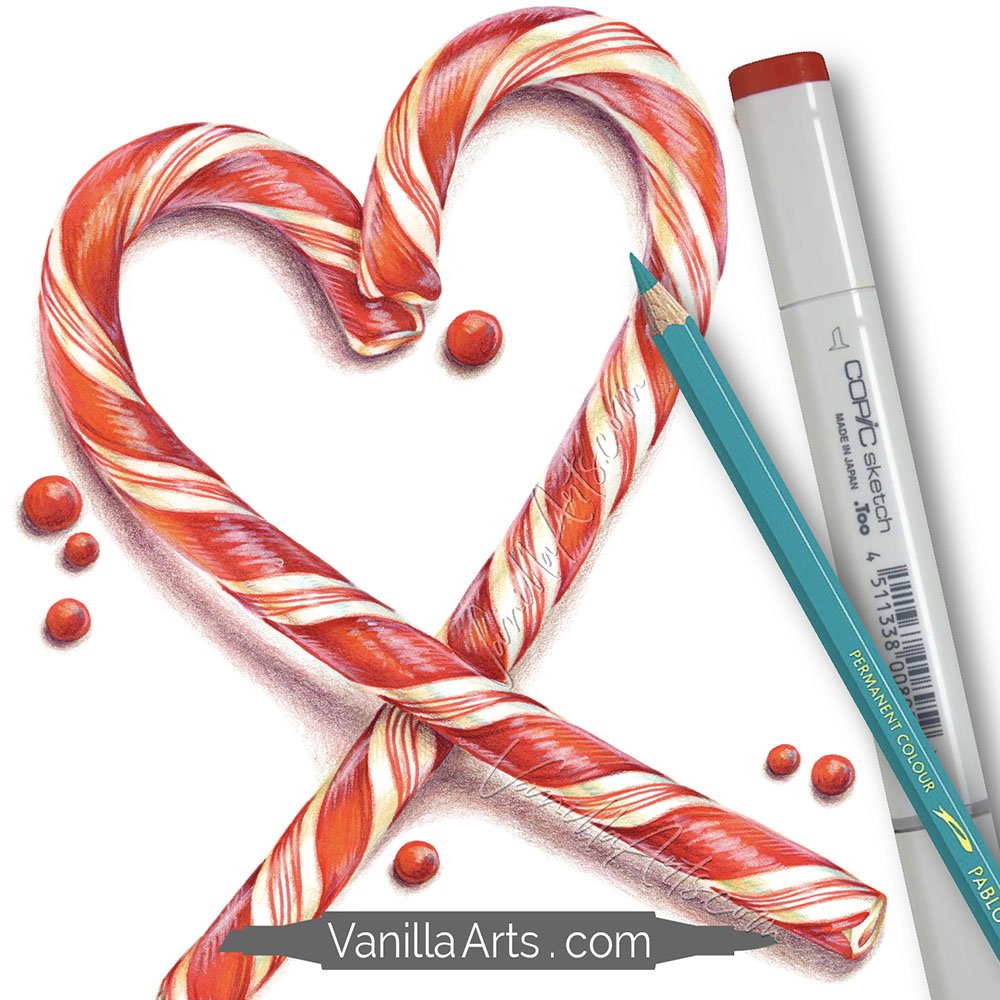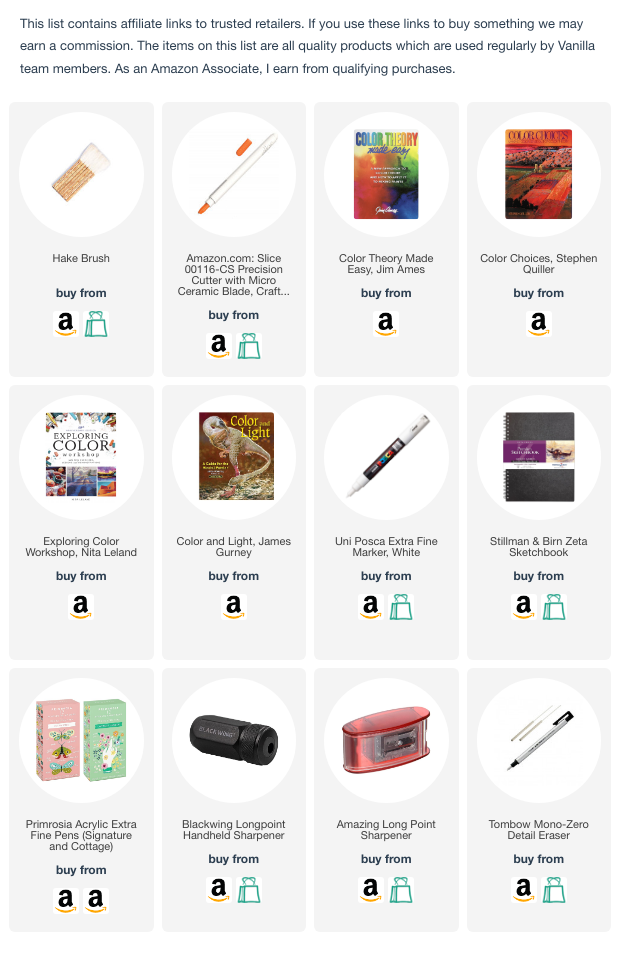Vanilla Beans: The Neighbor’s Swimming Pool
Thanks for taking the jump to read today’s newsletter. If you landed on this page by accident, subscribe to the Vanilla Beans Newsletter here.
The cough continues, my voice is barely a whisper, and I’m brain foggy from the medications.
Pneumonia is a b!tch.
Yes, I am resting which is made easier by the fact that my body just kinda automatically naps when I’ve worked more than a few hours.
YouTube and livestreams are still on hold. I can’t teach if I can’t talk. I appreciate your patience.
I am hoping to stream the Wonk and UP projects next week, cross your fingers for me.
Okay, so we’re starting this colored pencil info series…
Don’t worry, for all you color theory readers, I’ll still be throwing lots of theory into this series of articles—
It’s kinda hard to talk colored pencils without talking color, so even if you’re not into the pencil parts, the color stuff is applicable to other media.
And just to be clear:
I’m not trying to sell colored pencils.
I’m kinda anti-selling.
If I toss an affiliate link at you, it’s to provide an example. I'm not being salesy but if I’m going to tell you Brand X is good at doing Y and Z, I might as well make it an affiliate link on the off-chance that you eventually want it.
Just remember, goal is to understand what you already own before buying more stuff.
And when you do get ready to shop, I want you to go in with a concrete plan and select the best colored pencil to meet your needs.
THE NEIGHBOR’S SWIMMING POOL
Once upon a time, long before adult coloring was a thing…
Artists had two different types of art supplies.
And by “artists”, I mean people who’ve trained and earn a living making art.
I know you’re “artistic” but for just a bit, let’s use the term “artist” the way it was originally intended rather than the all-inclusive modern usage. I wish we had separate words for the two types of artist; more on that later.
Okay, so professional artists, we all have a primary medium— the durable, long term, expensive art supplies which we use to make framable, archival, salable art.
But professional artists also have a whole class of temporary, inexpensive, fast art supplies— the stuff we use to generate ideas and practice.
Fast art supplies include:
watercolor
gouache
pastel
markers
colored pencils
Before wasting time on a big project, artists do thumbnail sketches and color studies with a fast medium. We rehearse with second tier art supplies before beginning the expensive process.
Now sure, over the years, some artists are known for their pastel or watercolor art…
And commercial artists (like myself) can get really good with temporary mediums. When the art is meant to be photographed and printed, we don’t need to move to a final phase with oil or acrylic…
The reason I’m telling you this is to explain WHY many artist grade art supplies are not lightfast.
And it’s why formal art institutions, museums, and art society groups do not recognize the temporary mediums.
As much as we love markers and colored pencils, we must acknowledge that we are working with tools that were always meant to make disposable art.
This doesn’t mean that watercolor, pastel, and colored pencils are not real art supplies.
And it doesn’t mean they’re not artist grade, either.
It just means these art supplies were invented for studies, not final pieces.
It’s not a judgement thing. We’re not talking good/bad or quality/junk. All I’m saying is that there are levels of artist grade supplies. Colored pencils are not top tier because they’re intentionally cheap and fast.
Disposable and temporary isn’t bad.
Got it? Temporary is good.
You have to know the history of temporary art supplies to understand where we’re going…
Fast foward to today…
Coloring is a popular hobby and colored pencils look like the easiest place to start.
But you’re kinda here under a false assumption.
As an artist, I know perfectly-well that colored pencils are a second tier supply and it doesn’t bother me a bit…
The problem is, from the hobbyist perspective, colored pencils look like a top tier tool.
I’m not saying that you can’t make real art with colored pencils…
I’m just reminding you that you’re skinny-dippin’ in the neighbor’s swimming pool.
You’re playing with artist tools now.
Professional artists don’t pay attention to the craft and hobby world.
I once gave a corner-chomper as a white-elephant gift at the studio office party and grown men fought over the darned thing like it was gonna cure cancer.
Anyway, I’m trying to explain that artists didn’t know we needed to defend the term “artist” as a real profession which requires skill and training to meet an advanced level of competency. We’ve lost the word for people like me.
Suddenly, everyone’s an artist.
And because everyone’s an artist, “artist grade” has been watered down too.
Today, artist grade seems to mean whatever makes a crafter feel special.
Whatever gets you to spend money.
Once again, artists aren’t defending our definitions or enforcing our product standards.
So the very first thing you need to understand about colored pencils is that the market is toast. There are excellent colored pencils out there but they’re drowning in a pool of bad pencils manufactured by liars and thieves.
And you can’t tell the good from the ugly by reading labels. The box says whatever you want to hear:
Artist Grade!
Professional!
Premium!
Quality!
Highly Pigmented!
Nobody is policing the term “artist grade”. It could mean anything now.
Heck, they’ve even managed to make Crayola sound artistic.
C’mon, you fell for it, right? You’ve know from childhood that Crayola is for kids but somehow they’ve conned you into thinking “Crayola for Adults” is a real thing, eh?
Words mean nothing in Colored Pencil Land.
And the labels lie.
You can not trust the label on ANY box of colored pencils.
You’re swimming in the artist’s pool and there’s no lifeguard on duty. Artists have abandoned our post and you’re on your own.
Amazon is full of terrible pencils marked artist grade and professional. The lines are even blurry on art store websites.
You can’t even trust product reviews because strange new pencil companies pay for positive reviews.
The only way to tell if a colored pencil is artist grade is to test it yourself.
Over the next several weeks, I’m going to teach you what to look for.
But the first lesson is that YOU have to look.
The boxes lie and so does the influencer.
If you’re gonna play in this pool, you’ve gotta learn how to swim.
Affiliate links like this support free lessons here and at YouTube:
NOT A NEW VIDEO…
My voice is still crackly and YouTube is on hold until I can speak without coughing.
Here’s an older video, one you may have missed.
Click to watch. If your device doesn’t like embeds, click here to watch at YouTube.
IF YOU LIKED TODAY’S ARTICLE & VIDEO, PLEASE SUPPORT FUTURE FREE LESSONS
THIS WEEK IN COLOR
CURRENT PASSWORD: RubberDuckie
UPCOMING EVENTS
click to view details
VALENTINE COLORING
click for more info


























